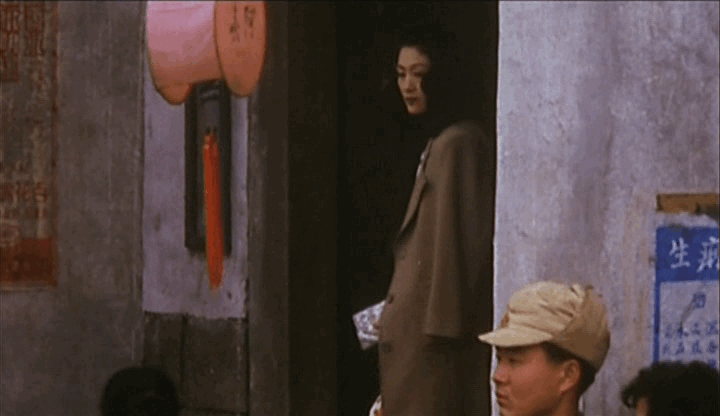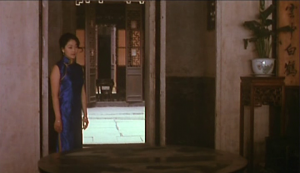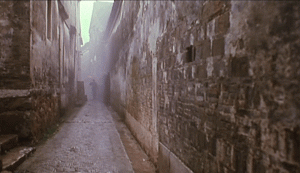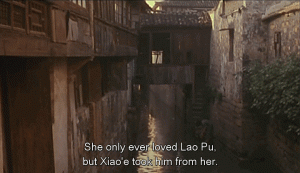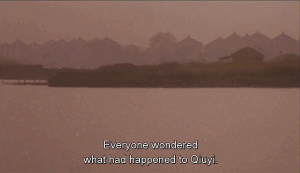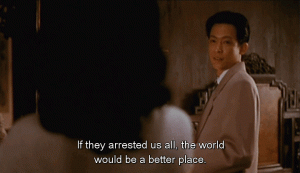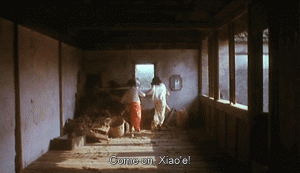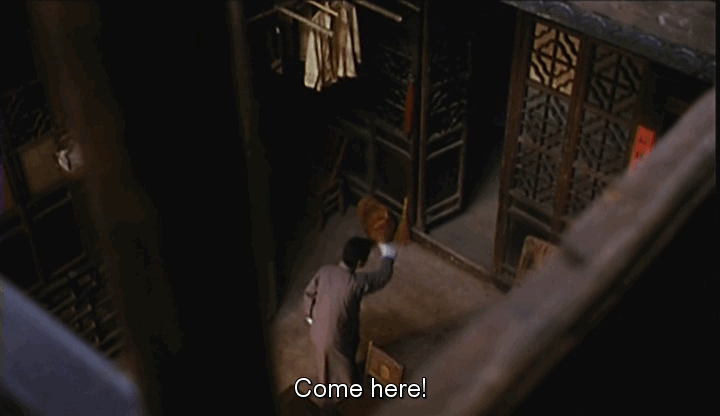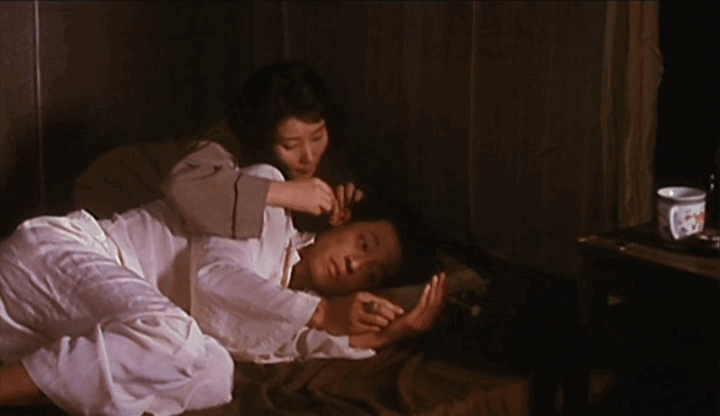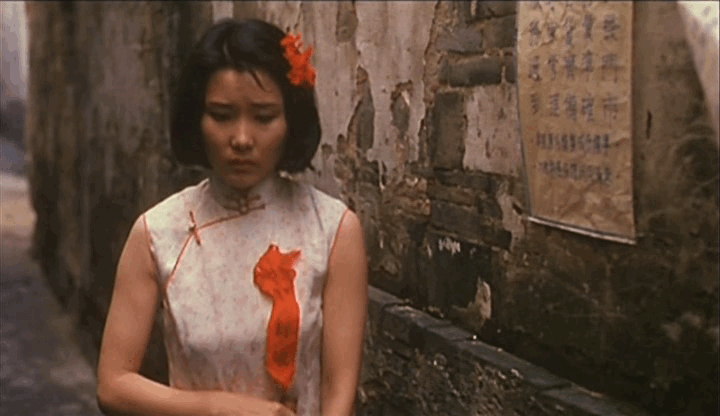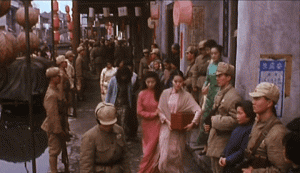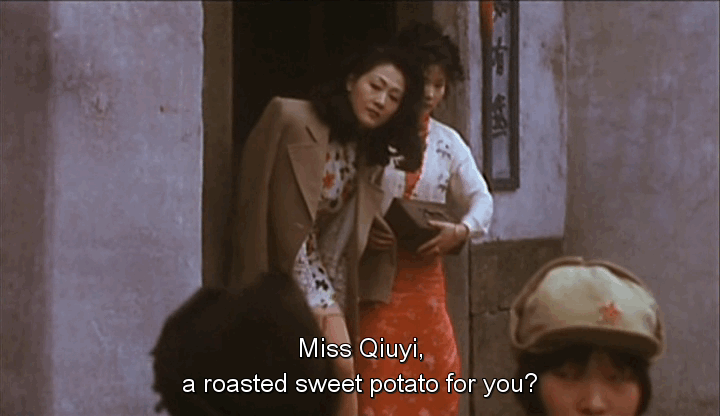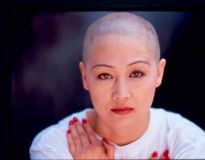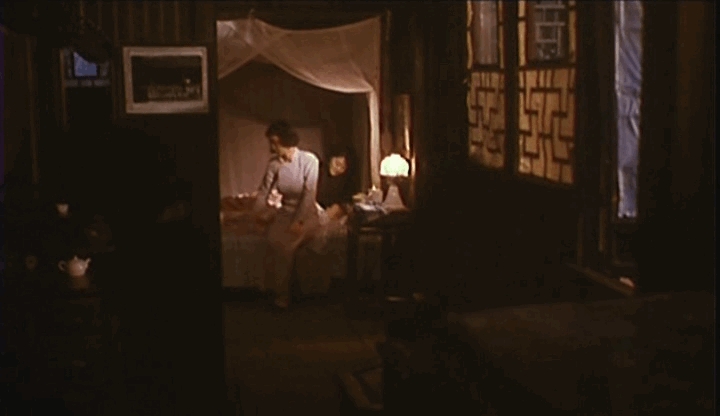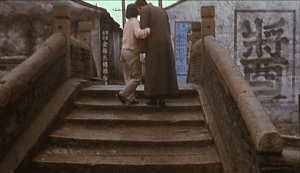From the Chicago Reader (October 4, 1996); also reprinted in my collection Essential Cinema. — J.R.
Blush
Rating **** Masterpiece
Directed by Li Shaohong
Written by Ni Zhen and Li
With Wang Ji, Wang Zhiwen, He Saifei, Zgang Liwei, Wang Rouli, Song Xiuling, Xing Yangchun, Zhou Jianying, and Cao Lei.
The use of multiple perspectives in Chinese painting was not for the purpose of making a hologram, nor was the use of parallel perspectives for the purpose of retaining the true dimensions of the objects represented. What was desired was rather a point of view which transcended that of the individual. The apparent horizon and vanishing point employed by Renaissance perspective made the image seem concrete, but demanded substantial identification with a particular viewer. Such images were perceived as both individual and momentary, seen by a particular person at a particular time. Chinese painting strove for a timeless, communal impression, which could be perceived by anyone, and yet was not a scene viewed by anyone in particular.
Chinese paintings did not portray reality; the world which the viewer entered was the realm of literature or philosophy, a realm which transcended nature. To enjoy a long tableau with small figures, one must shift one’s line of sight left and right, or up and down, a necessary condition for the appreciation of Chinese visual representation. This reminds one of the tracking technique used in films. When viewing a 30 cm × 10 m scroll which can only be enjoyed with the help of two persons unrolling and rolling the scroll at opposite ends (‘scrolling’ it past the viewer), one is in fact viewing a lengthy lateral tracking shot. — Hao Dazheng, “Chinese Visual Representation: Painting and Cinema”
There are a number of lengthy lateral tracking or crane shots in Li Shaohong’s Blush (1995), opening at the Music Box this week, and most if not all of them proceed from right to left, the same direction in which Chinese is written and read. Though we don’t often think about it, most lateral camera movements in Western movies proceed from left to right, the direction in which we write and read.
Of course the relation of writing to visual representation isn’t the same in China as in Western cultures. Anyone who attended the Art Institute’s recent superb “Splendors of Imperial China” show, drawn from Taipei’s National Palace Museum, noticed that most Chinese landscape painting contains writing — and therefore belongs to the realm of literature and philosophy, as Hao Dazheng suggests, rather than constituting a “portrayal of reality” in the Western sense. But because the linear flow of both writing and camera movement suggests a narrative, the direction in which the eye travels inflects the voyage taken by a reader or spectator in following a story — even if this individual reading doesn’t necessarily correspond to something “seen by a particular person at a particular time.” (A few of the more interesting right-to-left crane shots in Blush begin high over a courtyard, viewing events below in a ground-floor apartment, before proceeding through a window into the second-story apartment — a journey no ordinary individual could take.)
It’s been over a year and a half since I first saw Blush — the most emotionally complex picture I’ve seen from mainland China about the effect of the communist revolution on the lives of ordinary people — at the Berlin film festival, where it won one of the top prizes, the Silver Bear. It impressed me a great deal at the time, and reseeing it recently on video, I was only more impressed.
Admittedly, calling the three central characters of Blush “ordinary” may seem a stretch. Two of them are former high-class hookers at the same brothel, an establishment known as the Red Happiness Inn, located in an area called “Little Venice” — presumably because of its many canals — on the outskirts of Shanghai. The third is a former client of one of the prostitutes, a wealthy playboy who becomes an accountant after the revolution and winds up marrying the other former prostitute, now a factory worker. But even if these characters seem atypical, all of the action in Blush occurs after the revolution, when these three characters are scrambling to readjust to a new life. From this standpoint all three might be regarded as prototypical.
Blush was adapted by director Li Shaohong from a novel by Su Tong, a popular short-story writer whose better-known works include “Wives and Concubines,” the basis for Zhang Yimou’s Raise the Red Lantern, and “Opium,” the basis for Ho Fan’s Hong Kong feature The Szechuan Concubine. The only female member of China’s celebrated Fifth Generation of filmmakers — a group that includes Zhang Yimou, Chen Kaige, and Tian Zhuangzhuang — Li was born in 1955, but has made only four features to date. I haven’t seen the first, The Case of the Silver Snake (1988), a thriller commissioned by the Beijing Film Studio. But my interest was piqued by the second — a loose adaptation of Gabriel Garcia Marquez’s Chronicle of a Death Foretold known here as Bloody Dawn or Bloody Morning (1990); it was banned by the Chinese government but shown abroad. The third, a nuanced contemporary comedy-drama called Family Portrait, was even better.
Blush, better still, combines the virtues of Li’s two previous features — the detailed portrait of a community in Bloody Dawn with the canny domestic observations of Family Portrait. Like the previous Li pictures, it was shot by her cinematographer husband, the talented Zheng Nianping; her cowriter on Blush was Ni Zhen, a film critic and film teacher who also worked on the script for Raise the Red Lantern.
Much of the action in Blush is filmed in long shot, and when I asked Li whether she might have been influenced by similarly framed work of Japanese filmmaker Kenji Mizoguchi from the 30s and early 40s, her response was blank puzzlement. After I discovered that my pronunciation of Mizoguchi made the name indecipherable, and she figured out whom I was talking about, her answer was simply no: she knew some of Mizoguchi’s work, but the visual sources of Blush were basically Chinese painting.
I bring this up because, as a novice when it comes to Chinese painting and Chinese movies, not to mention Japanese cinema, I depend on cultural reference points — and priorities for them — that are substantially different from Li’s. On some level what I respond to in Mizoguchi’s films may parallel what Li responds to in Chinese paintings, but we come by our responses via different routes. Consequently I suspect it would have little or no meaning to Li that the Western film Blush most reminds me of is Orson Welles’s The Magnificent Ambersons, though using that reference point here may not be out of place.
Like The Magnificent Ambersons, Blush has an offscreen narrator who reports on events, gives impressions of the community, and comments on the characters, though here the narrator is a woman, and not one who should necessarily be identified with the filmmaker. (Welles does the narration in Ambersons; the commentary in Blush is delivered by an actress named Cao Lei.) Some of the other similarities are thematic (the declining fortunes of the rich, the cataclysmic effect social change has on lives and relationships, an overall sense of architecture as destiny) and formal (the aforementioned camera movements spanning action on separate floors of the same building, a preference for long shots over close-ups). On a deeper level, certain strains that might be regarded as both thematic and formal — such as individuals with blighted lives appearing to recede and blend in with their surroundings, becoming part of a much larger historical and social fabric, and the absence of a central figure who can unproblematically be designated “the hero” — are also common to both films. (As in Ambersons, all the characters in Blush are both flawed and sympathetic.)
Perhaps most pertinent is a sense of tragedy, in which moral growth (or at least education) is accompanied by a relentless decline in circumstances and fortune. This may be the most unexpected quality of all, for who in the West would have predicted that a mainstream film from mainland China could view the effects of the revolution with the dark, bittersweet irony that The Magnificent Ambersons views the effects of the coming of the automobile? To put it another way, this movie offers a better critique of communism than any American feature I can think of. (A closer look at the plot of Blush follows, so some readers may want to check out.)
Blush begins in 1949 with the rounding up of prostitutes from the Red Happiness Inn by Liberation Army soldiers, who transport them by barge to a new location for “re-education” as laborers. One of them, Qiuyi (Wang Ji), escapes across the rooftop, fleeing to the house of her favorite former client, Lao Pu (Wang Zhiwen), who invites her to live with him. Meanwhile her bereft and miserable best friend, Xiaoe (He Saifei), is put to work in a textile factory, where her only consolation is a bundle of gifts messengered to her by Qiuyi. After being prevented by a soldier from hanging herself, she’s asked in a reeducation class to explain why she made the attempt, and she explains that, unlike Qiuyi, she was born in the Red Happiness and has never known any other kind of life.
Lao Pu lives in a roomy house with his mother, and when she discovers Qiuyi’s background she tries to get her to leave. (Her initial ploy is an attempt to bribe Qiuyi with some of her old dresses.) When this doesn’t work, she exerts pressure on Pu, who finally relents and proposes to Qiuyi that he set her up in a love nest, a suggestion she angrily rejects, running off instead to take refuge in a Buddhist nunnery, where she’s forced to shave her head. By this time, however, Pu’s property is being confiscated by the government; he’s forced to move to a modest second-story flat and winds up working as an accountant.
One night he brings Xiaoe home with him; the next day she proposes that he marry and take care of her, and he eventually agrees. Qiuyi, who’s been expelled from the nunnery because she’s pregnant with Pu’s child, has a miscarriage and is reluctantly taken back by her family. She turns up briefly at Pu and Xiaoe’s wedding banquet with the gift of a bracelet and, as an afterthought, the useless umbrella she’s carrying. (The narrator notes wryly that the Chinese word for umbrella sounds like the word for separation.)
Xiaoe and Pu, who quarrel a lot, live above Mr. and Mrs. Zhang, who overhear and at times provoke their spats. Qiuyi eventually marries an older man who runs a teahouse (a character we never see). After Xiaoe gives birth to a son, nicknamed “Sad Man,” her relationship to Pu deteriorates further. Pu, out of guilt and love for Qiuyi, embezzles a large sum of money and sends it to her, but he’s caught and executed. (His execution is depicted on a rocky terrain in such an extreme long shot that we can barely make out what’s happening; this is the shot that seems to come closest to reproducing the human and natural scale of classical Chinese landscape painting.)
In the film’s final scene Qiuyi, who’s learned that she’ll never be able to have a child of her own, visits Xiaoe and her baby. They lie in bed together in the dark, and Qiuyi says she can still smell Lao Pu’s hair on the quilt. “How strange life is!” she says. The narrator then tells us that a year later “Xiaoe went off with a northerner,” giving her son to Qiuyi before she left. “Qiuyi changed his name to Xinhua — ‘New China.’ She raised him as her own and was content.”
The above summary can’t begin to do justice to the beautifully detailed plot and characters of Blush, much less to the emotional complexity of the narrator’s closing lines — a mixture of terminally dark wisdom and barely nascent hope that might also have been apparent in Welles’s original ending for Ambersons (the studio substituted a saccharine happy ending that is, alas, the only one we have on film). It adds up to a vision that’s both cosmic and brutally down to earth about what the communist revolution did to people — a vision, I suspect, that is as quintessentially Chinese as Ambersons is American.
To approach the question of what’s so Chinese about it, it’s worth returning to the example of Chinese painting — the multiple perspectives and the linear “narrative” flow evoked by Hao Dazheng. For throughout the richly textured story and shifting spaces of Blush we’re given the perspectives of three separate characters — each adding to rather than detracting from the perspectives of the other two — as well as a fourth perspective offered by the offscreen female narrator and a fifth offered by the camera’s vantage point, which is distinct from that of all the others. As in Chinese landscape paintings, there’s a continuity between interiors and exteriors, between human figures and their settings, between buildings and landscapes, between the abstract (notions such as “society,” “life,” and “the world”) and the mundane (such as the umbrella and the quilt). Moving from left to right, or from right to left, from courtyard to interior, from one floor and family to the next, from life to death, from prostitution to revolution, Li’s masterpiece proposes a way of reading the world as if it were literature or philosophy, a realm that transcends nature — a lengthy lateral tracking shot across history itself.

